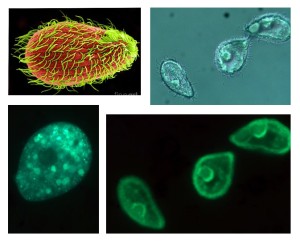Tetrahymena is a non-pathogenic, free-living, unicellular ciliate that presents a diverse and extremely versatile lipid metabolism, of potential use in numerous biotechnological applications.. From the Tetrahymena lipid system studies we have developed a capacity for molecular approach of the ciliate that has allowed us to characterize a significant group of genes linked to the synthesis and modification of complex lipids and various sterols, including hydroxylated, desaturated derivatives, phospholipids, sphingolipids and various glycolipids, all of them connected to the systems of expression and secretion of proteins of pharmaceutical, veterinary or nutritional interest..
In particular, we have shown that the ciliate Tetrahymena rperforms the conversion of cholesterol from food into pro-vitamin D3 and that this can serve as an original technology of interest to the food and chemical industry. The bioconversion of cholesterol into pro-vitamin D3 consists of a desaturation in the position C7(8) of the cholesterol molecule, a modification that Tetrahymena performs safely, selectively and efficiently.. Consequently, the conversion of cholesterol by the ciliate is a unique method that can be used to decrease the cholesterol content of foods and simultaneously enrich them in pro-vitamin D3, and, alternatively, to be considered as a new method for the industrial production of provitamin. We have recently identified the gene responsible for the activity by somatic knockout and RNA interference, and achieved its active expression in insect cell cultures.
This knowledge is currently used in the design of systems for the expression of vaccine antigens in the ciliate. In particular, current studies are aimed at the expression of several antigens of pathogenic protozoa of the phylum Apicomplexa: Babesiabovis, Cryptosporidium parvum and Ictiosporidiumsp.. The general objective in this case is the design of new vaccine strategies against parasitic diseases of veterinary importance, using as a platform for expression the ciliate Tetrahymena thermophila.
Principal Researcher
Dr. Alejandro Nusblat.
Group members
Dra. B. Clara Nudel.
Bioq. Nicolas Cid.
Bioq. Guadalupe Montes.
Dra. Eugenia Elguero.
Lic. Luz Sanchez Granel.